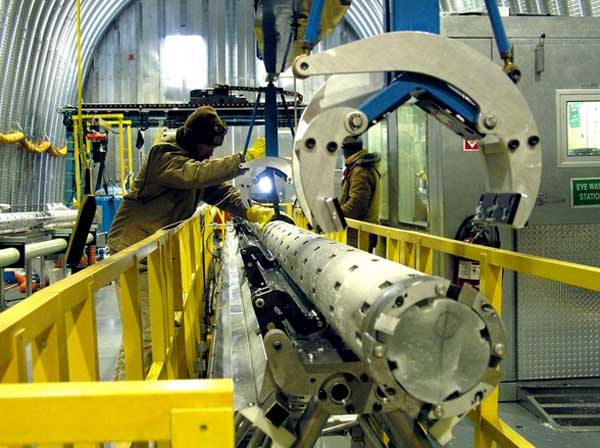Ice cores have been drilled and extracted at various locations on the major ice sheets of the world e.g. Greenland, West Antarctica and East Antarctica. The ice is formed as snow slowly compacts over thousands of years. The ice on these sheets can be very thick - over 3km (2 miles) thick and the deep ice can be over 200,000 years old. The extracted ice cores are used to understand the climate over such a time span. Gases trapped in tiny air bubbles are analyzed to gain insight into atmospheric composition over time, while the chemical and molecular (isotopic!) make up of the ice can tell us about large scale temperature regimes of the past.
 |
| Don Voigt working on an ice core. I spent a fascinating evening talking with Don, learning about how ice core drilling is done. To successfully retrieve a prefect ice core from 3000m below the surface requires technical and engineering expertise. Photo: antarcticsun.usap.gov |
 |
| The coring drill at WAIS Divide (WAIS = West Antarctic Ice Sheet). You can see the ice core in the drill casing. Photo: antarcticsun.usap.gov |
A couple of technical engineers were assembling an intriguing instrument in the lab next to me. In the borehole created by extracting an ice core, they will be sending down an instrument that will use beams of light to detect the crystal form of the ice found at these great depths. The scientist on this project want to understand the 'fabric of ice' meaning they want to know how dense the ice is, how large the individual ice crystals are and how these crystals are aligned. This instrument package will be slowly lowered down the borehole and will stop at various depths to remotely sense the ice.
 |
| Joe and Merlin working on the small rack of instruments that will be placed in a robust casing. The whole assembly has to be able to slide down the hole left by extracting an ice core; the hole is only 15cm (6 inches) in diameter. I will explain the instruments below. |
 |
| The casing to hold the instruments has to be very robust as it has to withstand high pressure. The borehole is filled with fluid (like anti-freeze) so that the hole stays open, but 3000m of fluid above an instrument creates high pressure. There are three small windows on the casing to allow light (or laser beam) from the instrument to shine on the ice. |
 |
| The two silver knobs on the instrument in the picture above are laser emitters and detectors. These knobs are actually angled slightly towards each other. One knob shoots a laser beam of light at the ice and the time it takes to reach the detector tells us about the density of the ice.This is due to the process of refraction. |
 |
| Three Light Emitting Diodes (LED's), each of which pulses a different color of light at the ice in the borehole. The amount of light reflected back for each color tells us about the form of the ice crystals. |
 |
| The LED detector processing unit. |
To learn more about ice coring follow this link to
WAIS Divide Ice Core Science.









0 Comments:
Post a Comment
Subscribe to Post Comments [Atom]
<< Home